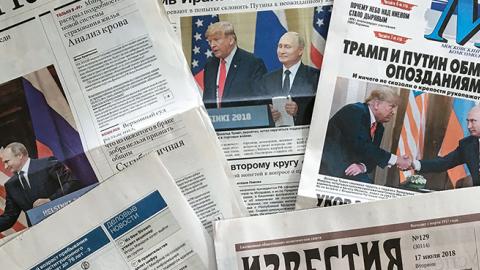Russia is anxious to extend the New Start Treaty, but the United States should not be. Vladimir Putin had purportedly raised the issue at the Helsinki summit, but President Trump has denied reaching any deal. The agreement expires in 2021, so it would be wise not to rush.
President Trump has reportedly criticized the New Start Treaty, which does have significant flaws and verification loopholes. Most concerning, while the Senate considered it, members received classified intelligence that caused several to oppose it. In 2010, Christopher Bond (R-Mo.), who at the time was vice chairman of the Senate Intelligence Committee, sent around a classified letter to his colleagues outlining what he identified as the irredeemable problems and circumstances surrounding the New Start Treaty. The information Bond had has yet to be made public.
Despite this, enough Republicans supported ratification. In a shrewd political move, now retired Senator Jon Kyl (R-Ariz.), perhaps calculating the inevitable ratification of the New Start Treaty, wrangled the Obama administration to commit billions of dollars to modernize the aging U.S. nuclear arsenal as it sought Senate support. These efforts to modernize the nuclear arsenal have continued under the Trump administration.
Additionally, the nuclear posture review of the Trump administration, unlike that of the Obama administration, unambiguously identifies Russia as a competitor with a concerning proclivity to threaten nuclear force. The report further calls for returning low yield nuclear warheads to submarine launched ballistic missiles and to develop a submarine launched cruise missile. These specific delivery systems would enable the United States to avoid the formidable Russian air defenses while providing a credible nuclear response option to the kinds of low yield nuclear weapons the Russians are brandishing vis-à-vis NATO allies.
By deploying these supplemental capabilities, the United States seeks to convince the Russians that it is wrong to presume that the Americans have neither an effective capability nor the will to employ a proportional response to an initial nuclear strike on a NATO ally, however small the yield. Barring any new information, such as the kind that senators received in 2010, and provided the Russians comply with the New Start Treaty and the United States bolsters the credibility of the U.S. nuclear deterrent force, then Washington should remain silent on what to do about the agreement. Of course, should any of these criteria change, there is little reason to stay in the New Start Treaty at all.
In the meantime, the United States should bolster its nuclear deterrent while also qualitatively improving U.S. missile defenses as the clock runs out until 2021. The Pentagon should follow through with its current plan to conduct research and development on the ground launched cruise missile. If deployed, this missile would violate the Intermediate Range Nuclear Forces Treaty. The Russians continue to violate it, so while American diplomats attempt to persuade the Russians to comply, it makes sense to develop the weapon if the agreement falls apart.
Importantly, the United States must reject the notion that strategic stability is achieved by remaining vulnerable to Russian and Chinese nuclear weapons. In 2002, President George W. Bush withdrew the United States from the Anti-Ballistic Missile Treaty, but the United States has effectively remained tied to the spirit of that agreement. It has done so by deploying missile defenses designed to only defend against the kinds of missile threats from rogue nations like North Korea and by constantly reiterating to both the Russians and the Chinese that U.S. missile defenses are not meant to degrade their respective offensive forces.
But even if what those diplomats say is true, and it is regarding the spectrum of missile defense options today, making the argument has essentially conceded to the Russians and the Chinese that the United States ought not to defend against their offensive missiles. But the United States is not obligated as a matter of stability or moral responsibility to expose our allies or American citizens to nuclear attack.
Decades after the Cold War, American technology has advanced such that the United States can deploy defenses that protect vulnerable U.S. assets that Russia and China can hold at risk. This would begin with rapidly deploying a sensor architecture in outer space that is necessary to track Russian and Chinese hypersonic missiles, and then to begin work on an interceptor layer also in outer space that would give the United States the ability to intercept enemy missiles in the boost phase.
The Russians will oppose all of it but that is no reason not to do it. In various ways, the president and his officials have repeatedly said they wanted dominance over U.S. adversaries rather than parity. Whether or not the United States extends the New Start Treaty must fit into this larger context. The agreement is a mere tool in the hands of the government. If the Trump administration deems it useful to extend it, it can do it closer to its deadline. Until then, the United States should strengthen its nuclear deterrent and its missile defense architecture, and let the Russians prove it can, for once, consistently comply with an agreement.



















